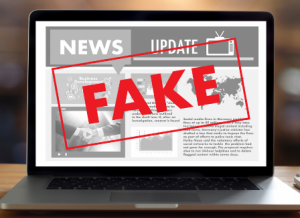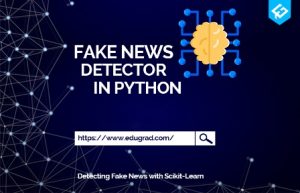Tackling the Menace of Fake News: Pandemic and Beyond
When the arbitrator becomes the collaborator or colluder with the creation and furthering of fake news, then democracy is seriously in trouble. Fake news can be eliminated only through responsible citizens focused on bringing the truth to light.
Fake news or misinformation was once only a prank most commonly practiced on 1st of April, ”The April Fool’s Day”. However, it has moved beyond from being a prank to being a call to action now days.  It is being created by some people to manipulate us in believing in the myths that make governments, promotes hatred towards some communities and lynch to destroy democracy and more. Today, every waking hour is an “April Fool’s Day” and we are reaching a point wherein many people are not able to differentiate between fake news and real news. Making the situation even worse, money and machine have joined hands against humans and humanity assisted by an active army of paid people ably assisted by Artificial Intelligence (AI) creating this virus.
It is being created by some people to manipulate us in believing in the myths that make governments, promotes hatred towards some communities and lynch to destroy democracy and more. Today, every waking hour is an “April Fool’s Day” and we are reaching a point wherein many people are not able to differentiate between fake news and real news. Making the situation even worse, money and machine have joined hands against humans and humanity assisted by an active army of paid people ably assisted by Artificial Intelligence (AI) creating this virus.
Studies have indicated that fake news travels six times faster than truthful facts and today in the time of pandemic, its pace and mutation possibilities are suspected to go beyond human comprehension. It will not be a surprise if soon the AI-aided news factory will diminish and ultimately obliterate human intelligence and relegate humanity to both political and economical slavery through fake news and misinformation. But thankfully on the other side, independent journalists and media professionals are now emerging at the forefront of fighting fake news aided by leaders of community led organisations that are at the intersection of bearing the impact of fake news as well as putting up a fight.
Recently, Praxis along with Partners in Change (PiC), brought together some of such individuals and leaders during its 34th webinar titled ‘Challenges from Fake News: Pandemic and Beyond’ to disaggregate the “fake news”. The participants in the webinar presented the perspectives of people who have dedicated their career to understanding and fighting fake news as well as of people at the receiving end who are challenging it.
Pratik Sinha, co-founder and editor of Alt News, which has been busting fake news for three and a half years, shared his knowledge on fake news, its impact and how to keep a check on it.
There is hardly any misinformation, which is politically neutral. Political parties, especially the right-wing parties, have actively learned to weaponise misinformation to create false narratives.
Also Read : Erosion of Democracy: How Culpable is Social Media?
“To hope that anything will be done institutionally, that is, the government will step in to make any positive intervention or any pillar of democracy will come in to make a consistent and positive intervention is unrealistic”, he said. It is now up to individuals and organisations, who have truly invested in this issue to take it up. Mainstream media organisations that exist today speak the same language. At the time when the pandemic has claimed thousands of lives, where unplanned lockdown brought miseries on thousands of people, especially the migrant labour and there is chaos all around,the media organizations chose to focus on one Bollywood issue. “With the whole system trying to ensure that real issues don’t reach people, it is important that multiple organisations, which are in the business of fact checking, come together and ensure that people know how both the mainstream media and the social media are being used in conjunction to mislead people”, he suggested.There are a lot of genuine reporters and new independent media organisations who are reporting from the ground and are exposing issues that are there with a lot of services that are being proposed by the government, but are actually not reaching the ground. The civil societies, especially which are not politically inclined should also come together and develop critical thought process at the ground level so that they may be aware of the possibility that they are being mislead especially when it comes to schemes proposed by the government. “We need to train and empower the community leaders with the debunking skills as it is their voice that people will believe the most as they have trust in that person that he is working for the benefit of the community”, he concluded.
Bringing forward the ground realities, leaders of three leading grass root organisations also shared their experience with fake news during the pandemic. Rukhsana Vora, a Team Leader at Sahyog, Ahmedabad, shared how fake news was used to target minorities who were alleged of being the carriers of infections. In many of the societies, boards were put restricting the entry of vegetable hawkers belonging to minorities. “The maximum number of unemployment is among the minorities who are auto drivers, vegetable vendors and do other small occupations. The MGNREGA is also not applicable to the urban poor and where it is proper implementation is not there”, she said. Due to the discrimination faced by them accompanied by a government who turned a deaf ear to the whole issue, their lives and livelihoods were adversely affected. Many lost the trust in the government and preferred visiting the chemist shops to take medicines rather than going to government hospitals.
 With more than two decades of working in the development sector, Bharat Kantharia, associated with a community based organisation Samta Charitable Trust in Surat, Gujarat and S.D.L Vennila, women coordinator in Trust for Social Justice Shanthi Nilayam, Villupuram, voiced a similar concern. They shared that in both the states, after the announcement of lockdown, daily wage labours and workers with limited livelihood options were not included in any of the policies which impacted their livelihood, health, family and mental wellbeing. The rumours around about the spread of COVID-19 added to their dilemma. “The hawkers were evicted from near the societies as there were rumors that COVID-19 spreads through some vegetables. Police and municipality also restricted their vegetable selling time from fifteen minutes to one hour”, said Bharat Kantharia. The domestic helps, flower sellers, workers in textile market, smaller service providers were all completely isolated from their work,as their employers believed them to be the carriers of the virus as they resided in slums.
With more than two decades of working in the development sector, Bharat Kantharia, associated with a community based organisation Samta Charitable Trust in Surat, Gujarat and S.D.L Vennila, women coordinator in Trust for Social Justice Shanthi Nilayam, Villupuram, voiced a similar concern. They shared that in both the states, after the announcement of lockdown, daily wage labours and workers with limited livelihood options were not included in any of the policies which impacted their livelihood, health, family and mental wellbeing. The rumours around about the spread of COVID-19 added to their dilemma. “The hawkers were evicted from near the societies as there were rumors that COVID-19 spreads through some vegetables. Police and municipality also restricted their vegetable selling time from fifteen minutes to one hour”, said Bharat Kantharia. The domestic helps, flower sellers, workers in textile market, smaller service providers were all completely isolated from their work,as their employers believed them to be the carriers of the virus as they resided in slums.
Giving an in-depth insight to the origination and statistics behind fake news Jency Jacob, managing editor of BOOM, India’s premier fact checking digital initiative based out of Mumbai, gave a presentation on how misinformation was spread not only about the virus, but was given a communal angle too. As per his research, political IT cells had built a robust online army much before the mainstream media discovered social media.
With 290 million Facebook users and 340 million WhatsApp users in India, which are the highest around the world, more fact checkers are needed because they look at content ignored by the mainstream media and are independent entities free from government or corporate pressure.
Also Read : You’ve got a video, and it’s fake!
“On WhatsApp the fake news is more common as many of the users lack media literacy on how to consume news and the misinformation thrives in regional languages away from the scrutiny of English or Hindi mainstream media. Moreover, since WhatsApp is end-to-end encrypted, anonymity becomes the key in spreading rumors”, he said. There have been instances where people were also killed because of fake news, and as per the data, 35 people died since 2017. Mobs have even lynched innocents who they believed were child kidnappers and these people didn’t even fear the law and attacked the police too who came to the innocent’s rescue, such was the impact of fake news. Recent case was of Palghar in Maharashtra where two Hindu sadhus were killed because they were suspected of being child kidnappers. “If we compare the 2014 elections with 2019 elections, there has been an exponential rise of voters who are being touched by the multiple social media platforms. Further, in 2014, there were no fact checkers on social media and by 2019, 10 organised websites were built to do fact checking”, he shared. He also shared ways to do fact checks which included the use of Google reverse image search, looking for credible mainstream media reports, reaching out to the official sources for comments, calling local police and sending reporters to verify and not using anonymous source based but only primary source-based information.
Madhupa, Founder Dean of The Heritage Academy, Kolkata and Professor in the Department of Media Science, said with students in premier brands like Times Now, CNN IBN, Wunderman Thomson, Netflix and many more popular media houses shared that she not only teaches her students about media literacy,but also about its use and pitfalls. Students who come from a certain background and well to do families also face the bad side of fake news and misinformation that goes around.“Looking forward it should be our responsibility to train this youth so that that they can go out and dispel this information. In the long-term misinformation will only thrive if there is less literacy and consciousness around hard news”, said Madhupa.
Tom Thomas, CEO, Praxis, said, “We are the product for social media platforms like Facebook and WhatsApp, and when this recognition comes that a huge range of AI and science is working together along with money power of politics to propagate fake news through us, then only we will become more alert about media literacy. When the arbitrator becomes the collaborator or colluder with the creation and furthering of fake news, then democracy is seriously in trouble. Therefore, it is the role of every citizen, both as individual and as well as collective, to try and overcome this.”
